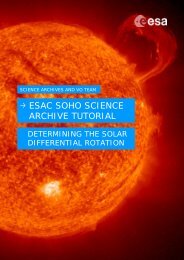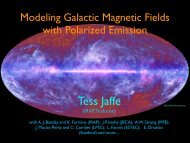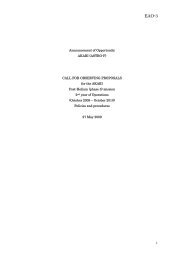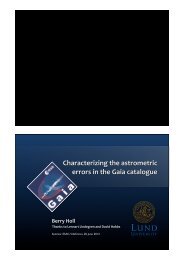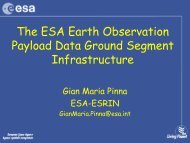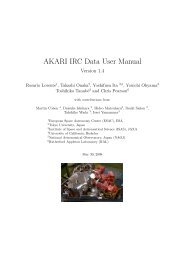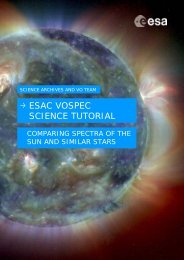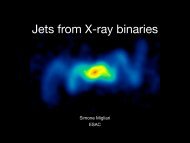Cyclotron line in accreting binaries
Cyclotron line in accreting binaries
Cyclotron line in accreting binaries
Create successful ePaper yourself
Turn your PDF publications into a flip-book with our unique Google optimized e-Paper software.
Study of cyclotron <strong>l<strong>in</strong>e</strong> sources, the<br />
present and the future.<br />
ESAC 28.06.2012<br />
INTEGRAL and cyclotron <strong>l<strong>in</strong>e</strong>s - C.Ferrigno<br />
1
Out<strong>l<strong>in</strong>e</strong><br />
• A quick summary<br />
• A theoretical study on the orig<strong>in</strong> of cyclotron <strong>l<strong>in</strong>e</strong> energy flux<br />
dependency<br />
• New INTEGRAL determ<strong>in</strong>ation of a positive flux-centroid<br />
energy <strong>in</strong> GX 304-1<br />
• IGR J18179-1621: a new cyclotron source ?<br />
• RX J0440.9+4431: a new cyclotron <strong>l<strong>in</strong>e</strong> source.<br />
• Prospects for future missions.<br />
ESAC 28.06.2012<br />
INTEGRAL and cyclotron <strong>l<strong>in</strong>e</strong>s - C.Ferrigno<br />
2
High B-field:<br />
an ubiquitous phenomenon<br />
• Low mass X-ray b<strong>in</strong>aries normally<br />
associated with low-B (10 8-9 G)<br />
neutron star (old systems). An<br />
exception is, e.g., Her X-1<br />
– Roche lobe overflow -><br />
accretion disk<br />
– transient or persistent<br />
• Be-Xray b<strong>in</strong>aries are very<br />
important, as they become very<br />
bright dur<strong>in</strong>g outbursts and give<br />
high S/N<br />
• High mass X-ray b<strong>in</strong>aries are<br />
normally young systems, where<br />
NS has a high B-field (10 12-13 G)<br />
– w<strong>in</strong>d-fed systems but with<br />
formation of transient accretion<br />
disk<br />
– transients or persistent<br />
L outburst<br />
X<br />
L quiescence<br />
X<br />
∼ 10 3<br />
ESAC 28.06.2012 INTEGRAL and cyclotron <strong>l<strong>in</strong>e</strong>s - C.Ferrigno<br />
3
Some famous sources<br />
Be-b<strong>in</strong>aries<br />
• 4U 0115+63:<br />
– B ~ 10 12 G, the lowest<br />
– Fundamental cyclotron <strong>l<strong>in</strong>e</strong> plus 5<br />
higher harmonics detected<br />
– Psp<strong>in</strong>=3.6 s. Spectrum is highly<br />
variable with sp<strong>in</strong> phase.<br />
• V 0332+53:<br />
– B ~ 2x10 12 G, 3 harmonics<br />
– Psp<strong>in</strong>=4.4 s not very variable with<br />
sp<strong>in</strong> phase<br />
• A 0535+262:<br />
– B ~ 5x10 12 G, 2 harmonics<br />
– Psp<strong>in</strong>= 103 s<br />
• Her X-1:<br />
– B ~ 4x10 12 G<br />
Roche lobe overflow<br />
– Fundamental cyclotron <strong>l<strong>in</strong>e</strong> plus 1<br />
higher harmonic<br />
– Psp<strong>in</strong>=1 s. Spectrum is highly<br />
variable with sp<strong>in</strong> phase and<br />
superorbital modulation<br />
Amsterdam 27.10.2011<br />
Tim<strong>in</strong>g and spectroscopy of HMXB - C.Ferrigno<br />
4
Emission mechanisms<br />
<strong>in</strong> a high magnetic field<br />
• Accret<strong>in</strong>g matter acquires a high<br />
k<strong>in</strong>etic energy v~c/2 which is partially<br />
dissipated close to the compact object<br />
surface and emitted <strong>in</strong> the form of X<br />
and Gamma-rays.<br />
• If the neutron star has a considerable<br />
magnetic field, the accret<strong>in</strong>g matter is<br />
channeled at the magnetic poles<br />
along the field <strong>l<strong>in</strong>e</strong>s and accretes on<br />
the poles.<br />
• For high accretion rates, radiation<br />
dom<strong>in</strong>ates: a radiative shock and<br />
accretion column form.<br />
• Seed photons com<strong>in</strong>g from thermal<br />
mound and electron breemstrahlung,<br />
<strong>in</strong> the high B-field, are Compton<br />
scattered.<br />
Becker & <br />
Wolff <br />
(2007)<br />
ESAC 28.06.2012 INTEGRAL and cyclotron <strong>l<strong>in</strong>e</strong>s - C.Ferrigno<br />
5
Kreikenbohm et al. (2005)<br />
<strong>Cyclotron</strong> scatter<strong>in</strong>g<br />
absorption features<br />
• Electrons are exited to the first Landau level and then re-emit<br />
• To be observed <strong>in</strong> the X-ray doma<strong>in</strong>, a B-field of 10 12-13 G is required.<br />
4.4×10 13 G<br />
• Discovered on the spectrum of Her X-1 (Trumper 1977, 1978)<br />
<strong>Cyclotron</strong> <strong>l<strong>in</strong>e</strong>s<br />
Trumper et al. (1978)<br />
V 0332+53<br />
ESAC 28.06.2012<br />
Isenberg et al. (1998)<br />
INTEGRAL and cyclotron <strong>l<strong>in</strong>e</strong>s - C.Ferrigno<br />
6
Cont<strong>in</strong>uum physical model<br />
• One long BeppoSAX observation <strong>in</strong> 1999. We <strong>in</strong>troduced the<br />
cyclotron emission model, and added a lower energy<br />
Comptonization component. Satisfactory description of the<br />
properties of 4U 0115+634.<br />
Thermal<br />
Comptonization of<br />
0.5 keV BB<br />
T_e ~ 2-3 keV<br />
CompTT<br />
Gaussian to<br />
correct the rough<br />
model<strong>in</strong>g<br />
Thermal and bulk<br />
Comptonization of<br />
cyclotron emission.<br />
T_e ~ 6-10 keV<br />
B ~ 0.6-0.8 10 12 G<br />
(Becker & Wolff, 2007)<br />
Ferrigno et al. (2009)<br />
Amsterdam 27.10.2011<br />
Tim<strong>in</strong>g and spectroscopy of HMXB - C.Ferrigno<br />
7
Soft scatter<strong>in</strong>g halo?<br />
Ferrigno et al. (2009)<br />
• Pronounced phase variations of<br />
cont<strong>in</strong>uum and <strong>l<strong>in</strong>e</strong>s.<br />
• Hard component prom<strong>in</strong>ent <strong>in</strong> the<br />
peak, soft component spread <strong>in</strong><br />
phase: a scatter<strong>in</strong>g halo?<br />
Amsterdam 27.10.2011<br />
Tim<strong>in</strong>g and spectroscopy of HMXB - C.Ferrigno<br />
8
Lum<strong>in</strong>osity dependent Ecyc<br />
V 0332+53<br />
Tsygankov et al (2006,<br />
2010)<br />
Her X-1<br />
Staubert et al (2008)<br />
• RXTE/INTEGRAL data <strong>in</strong> 3-100<br />
keV band<br />
• Anti correlation with lum<strong>in</strong>osity<br />
• Radiation enlarges the column<br />
• RXTE data of ma<strong>in</strong>-on<br />
(obscuration from disc)<br />
• Correlation with lum<strong>in</strong>osity<br />
• Accretion squeezes the column<br />
ESAC 28.06.2012<br />
INTEGRAL and cyclotron <strong>l<strong>in</strong>e</strong>s - C.Ferrigno<br />
9
Pulse to Pulse Variability<br />
• Dur<strong>in</strong>g the bright phase (!) of<br />
an outburst<br />
• Rate resolved spectroscopy<br />
reveals trend !<br />
• Evidence of different<br />
accretion regimes <strong>in</strong> four<br />
bright sources<br />
Klochkov et al (2011)<br />
V 0332+53<br />
ESAC 28.06.2012<br />
INTEGRAL and cyclotron <strong>l<strong>in</strong>e</strong>s - C.Ferrigno<br />
10
Different accretion regimes<br />
Becker et al. (2012)<br />
• Column is a region magnetically conf<strong>in</strong>ed<br />
• Depend<strong>in</strong>g on its width and amount of accretion, radiation can<br />
play an important role.<br />
• Edd<strong>in</strong>gton limit must be adapted for the geometrical and cross<br />
section effects<br />
Radius of the column<br />
ESAC 28.06.2012<br />
INTEGRAL and cyclotron <strong>l<strong>in</strong>e</strong>s - C.Ferrigno<br />
Cross section parallel to B-field<br />
11
A critical lum<strong>in</strong>osity<br />
Height of the radiative shock<br />
• Equation is derived follow<strong>in</strong>g Basko & Sunyaev (1977) by:<br />
– assum<strong>in</strong>g a strong radiative shock (L > LEdd)<br />
– free-fall velocity (vff) upstream and vps= 1/7 vff downstream<br />
– constant deceleration below the shock<br />
– radiation brak<strong>in</strong>g<br />
Becker et al. (2012)<br />
ESAC 28.06.2012<br />
INTEGRAL and cyclotron <strong>l<strong>in</strong>e</strong>s - C.Ferrigno<br />
12
Comparison to data<br />
• Use the surface magnetic field and assume a dipole structure,<br />
a variation of the emission height translates <strong>in</strong>to a variation of<br />
the observed cyclotron scatter<strong>in</strong>g centroid energy<br />
• where h is hs or hc <strong>in</strong> the two regimes<br />
Becker et al. (2012)<br />
ESAC 28.06.2012<br />
INTEGRAL and cyclotron <strong>l<strong>in</strong>e</strong>s - C.Ferrigno<br />
13
Comparison to data<br />
Becker et al. (2012)<br />
ESAC 28.06.2012<br />
INTEGRAL and cyclotron <strong>l<strong>in</strong>e</strong>s - C.Ferrigno<br />
14
4U 0115+63, is the <strong>l<strong>in</strong>e</strong> variation real?<br />
• Only the fundamental shows a variation, the higher harmonics<br />
are stable !! -> fit is wrong (2008 outburst us<strong>in</strong>g NPEX<br />
cont<strong>in</strong>uum model)<br />
Li et al. (2012)<br />
ESAC 28.06.2012<br />
INTEGRAL and cyclotron <strong>l<strong>in</strong>e</strong>s - C.Ferrigno<br />
15
NPEX<br />
Best fit (1)<br />
No <strong>l<strong>in</strong>e</strong>s (2)<br />
• I call it Wrong !!!!!<br />
• Large sigma <strong>in</strong><br />
Gaussian or width <strong>in</strong><br />
Lorentzian <strong>l<strong>in</strong>e</strong>s.<br />
ESAC 28.06.2012<br />
INTEGRAL and cyclotron <strong>l<strong>in</strong>e</strong>s - C.Ferrigno<br />
16
High energy cut-off PL<br />
(1)<br />
(2)<br />
• Still artificial suppression of cont<strong>in</strong>uum<br />
ESAC 28.06.2012<br />
INTEGRAL and cyclotron <strong>l<strong>in</strong>e</strong>s - C.Ferrigno<br />
17
High-E cut-off PL+ 9 keV Gaussian<br />
(1)<br />
(2)<br />
• More correct<br />
ESAC 28.06.2012<br />
INTEGRAL and cyclotron <strong>l<strong>in</strong>e</strong>s - C.Ferrigno<br />
18
Cont<strong>in</strong>uum variations !<br />
Mueller, Ferrigno et al. (<strong>in</strong> prep)<br />
• Adopt a more complex cont<strong>in</strong>uum, so that the <strong>l<strong>in</strong>e</strong>s do not<br />
fudge the cont<strong>in</strong>uum itself<br />
ESAC 28.06.2012<br />
INTEGRAL and cyclotron <strong>l<strong>in</strong>e</strong>s - C.Ferrigno<br />
19
Lum<strong>in</strong>osity dependency vanishes<br />
Mueller, Ferrigno et al. (<strong>in</strong> prep)<br />
• Coherent fundamental and first harmonic non-variation<br />
ESAC 28.06.2012<br />
INTEGRAL and cyclotron <strong>l<strong>in</strong>e</strong>s - C.Ferrigno<br />
20
INTEGRAL observations of GX 304-1<br />
• Outburst <strong>in</strong> 2011 when it reached Crab-like flux<br />
• A flux-cyclotron <strong>l<strong>in</strong>e</strong><br />
positive correlation has<br />
been reported dur<strong>in</strong>g<br />
previous outbursts us<strong>in</strong>g<br />
Suzaku and RXTE<br />
Klochkov et al. (2012)<br />
ESAC 28.06.2012<br />
INTEGRAL and cyclotron <strong>l<strong>in</strong>e</strong>s - C.Ferrigno<br />
21
Positive correlation<br />
• Beautiful measures of another<br />
subcritical system<br />
Klochkov (2012)<br />
ESAC 28.06.2012<br />
INTEGRAL and cyclotron <strong>l<strong>in</strong>e</strong>s - C.Ferrigno<br />
22
A new cyclotron source ?<br />
Bozzo, Ferrigno et al. (2012)<br />
• IGR J18179-1621 discovered dur<strong>in</strong>g quick-look (ATeL #3947)<br />
• Observed by INTEGRAL serendipitously<br />
• Swift/XRT follow-up campaign<br />
• Strong <strong>in</strong>dication of a cyclotron <strong>l<strong>in</strong>e</strong> a ~20 keV<br />
ESAC 28.06.2012<br />
INTEGRAL and cyclotron <strong>l<strong>in</strong>e</strong>s - C.Ferrigno<br />
23
Difficult tim<strong>in</strong>g study<br />
Data<br />
Simulations<br />
ESAC 28.06.2012<br />
INTEGRAL and cyclotron <strong>l<strong>in</strong>e</strong>s - C.Ferrigno<br />
24
Tim<strong>in</strong>g results<br />
• Estimate confidence of<br />
determ<strong>in</strong>ation us<strong>in</strong>g MC<br />
simulation and Z 2 statistics<br />
technique<br />
• At 99% c.l., we can reta<strong>in</strong> just<br />
4 out of 9 determ<strong>in</strong>ations<br />
Bozzo, Ferrigno et al. (2012)<br />
ESAC 28.06.2012<br />
INTEGRAL and cyclotron <strong>l<strong>in</strong>e</strong>s - C.Ferrigno<br />
25
RX J0440.9+4431= LS V +44 17<br />
Usui et al. (2012)<br />
Tsygankov et al. (2012)<br />
• Classified as persistent Be/X-ray b<strong>in</strong>ary at 3.3 kpc distance<br />
• Series of flares separated of ~155 days <strong>in</strong> 2010-2011<br />
• Three papers published and one <strong>in</strong> preparation<br />
ESAC 28.06.2012<br />
INTEGRAL and cyclotron <strong>l<strong>in</strong>e</strong>s - C.Ferrigno<br />
26
A dip-like structure at high L<br />
Usui et al. (2012)<br />
• A dip-like structure appeared dur<strong>in</strong>g the first outburst at soft X-<br />
rays<br />
• Interpreted as due to occultation from the accretion stream<br />
• Introduced a very soft BB for a better fit (the accretion<br />
stream?)<br />
ESAC 28.06.2012<br />
INTEGRAL and cyclotron <strong>l<strong>in</strong>e</strong>s - C.Ferrigno<br />
27
A cyclotron absorption <strong>in</strong> INTEGRAL<br />
Tsygankov et al. (2012)<br />
• Hard X-ray coverage by INTEGRAL of second outburst<br />
• Discovery of an absorption feature due to cyclotron scatter<strong>in</strong>g<br />
• Magnetic field strength confirmed by PSD analysis.<br />
ESAC 28.06.2012<br />
INTEGRAL and cyclotron <strong>l<strong>in</strong>e</strong>s - C.Ferrigno<br />
28
RXTE-Swift/XRT follow-up<br />
Ferrigno et al. (<strong>in</strong> prep.)<br />
• Analysis of Swift/BAT data confirms periodicity and gives a<br />
typical Be/X-ray b<strong>in</strong>ary orbital light curve Porb=(147.9+/-0.3)<br />
ESAC 28.06.2012<br />
INTEGRAL and cyclotron <strong>l<strong>in</strong>e</strong>s - C.Ferrigno<br />
29
RXTE-Swift/XRT follow-up<br />
Ferrigno et al. (<strong>in</strong> prep.)<br />
• Spectral harden<strong>in</strong>g as function of lum<strong>in</strong>osity, the same <strong>in</strong> three<br />
outbursts, due to high Ecut and larger BB area<br />
• Spectrum is comb<strong>in</strong>ation of BB+cutoffPL with low absorption<br />
NH~0.7x10 22 cm -2<br />
• BB not detectable at low lum<strong>in</strong>osity with RXTE but detected <strong>in</strong><br />
quiescence by XMMM-Newton (La Palombara et al., 2011)<br />
ESAC 28.06.2012<br />
INTEGRAL and cyclotron <strong>l<strong>in</strong>e</strong>s - C.Ferrigno<br />
30
BB radius and lum<strong>in</strong>osity<br />
Ferrigno et al. (<strong>in</strong> prep.)<br />
• BB radius <strong>in</strong>creases with L, as expected <strong>in</strong> disk-fed systems<br />
• slope is steeper than expected if BB radius is coupled with<br />
magnetospheric radius<br />
• At highest lum<strong>in</strong>osity, decrease ?<br />
ESAC 28.06.2012<br />
INTEGRAL and cyclotron <strong>l<strong>in</strong>e</strong>s - C.Ferrigno<br />
31
Future<br />
ESAC 28.06.2012<br />
INTEGRAL and cyclotron <strong>l<strong>in</strong>e</strong>s - C.Ferrigno<br />
32
Astro-H potential<br />
Ferrigno et al. (2009) SAX<br />
• 4U 0115+63 <strong>in</strong> outburst, fit with a complex model us<strong>in</strong>g Beppo-<br />
SAX broad-band data (45 ks)<br />
• Astro-H will provide <strong>in</strong> 10 ks a better constra<strong>in</strong>ts on relevant<br />
parameters (<strong>l<strong>in</strong>e</strong> width at 0.2 keV) and a slightly larger band !<br />
ESAC 28.06.2012<br />
INTEGRAL and cyclotron <strong>l<strong>in</strong>e</strong>s - C.Ferrigno<br />
33
LOFT<br />
LOFT<br />
SAX 45 ks<br />
LOFT 3.6 s<br />
• Smaller band prevents cont<strong>in</strong>uum study, but large effective<br />
area provides spectral ability on one pulse time-scale.<br />
• L<strong>in</strong>e centroids at better than 1 keV <strong>in</strong> 3.6s exposure !<br />
• Variability study at pulse time scale -> trace accretion.<br />
ESAC 28.06.2012<br />
INTEGRAL and cyclotron <strong>l<strong>in</strong>e</strong>s - C.Ferrigno<br />
34
Conclusions<br />
• The presented theoretical study furnishes a robust<br />
understand<strong>in</strong>g of the cyclotron <strong>l<strong>in</strong>e</strong> flux dependency <strong>in</strong> different<br />
sources with different trend.<br />
• We also demonstrated that <strong>in</strong> the case of 4U 0115+63, the<br />
observational result is doubtful.<br />
• The use of archive data is limited and it would be important to<br />
discover more sources show<strong>in</strong>g this effect.<br />
• It is essential to use a facility with high-energy coverage as<br />
INTEGRAL and Suzaku (Astro-H and LOFT <strong>in</strong> the future).<br />
• However, Suzaku normally does not provide extended<br />
coverage of an outburst as INTEGRAL.<br />
ESAC 28.06.2012<br />
INTEGRAL and cyclotron <strong>l<strong>in</strong>e</strong>s - C.Ferrigno<br />
35



